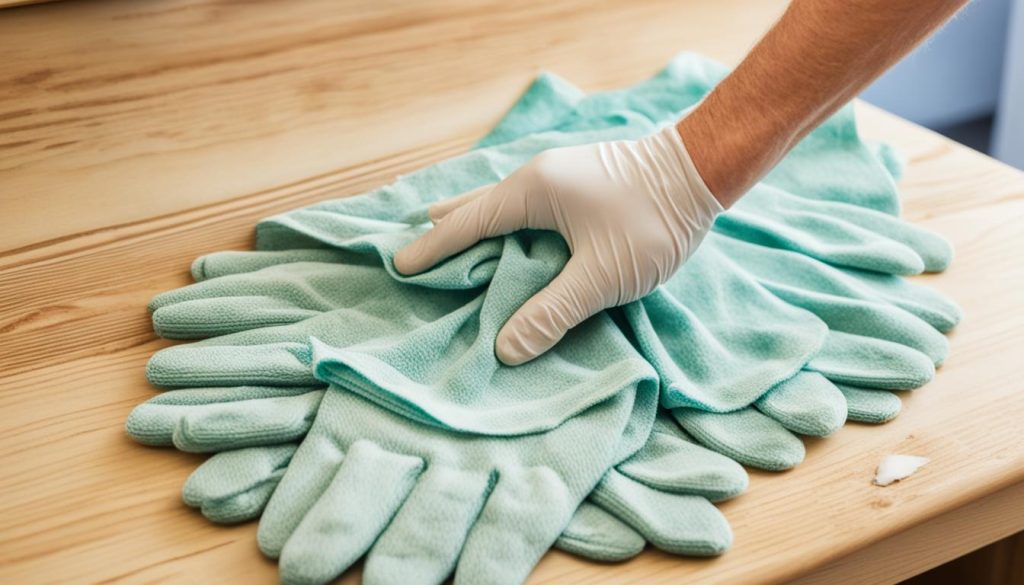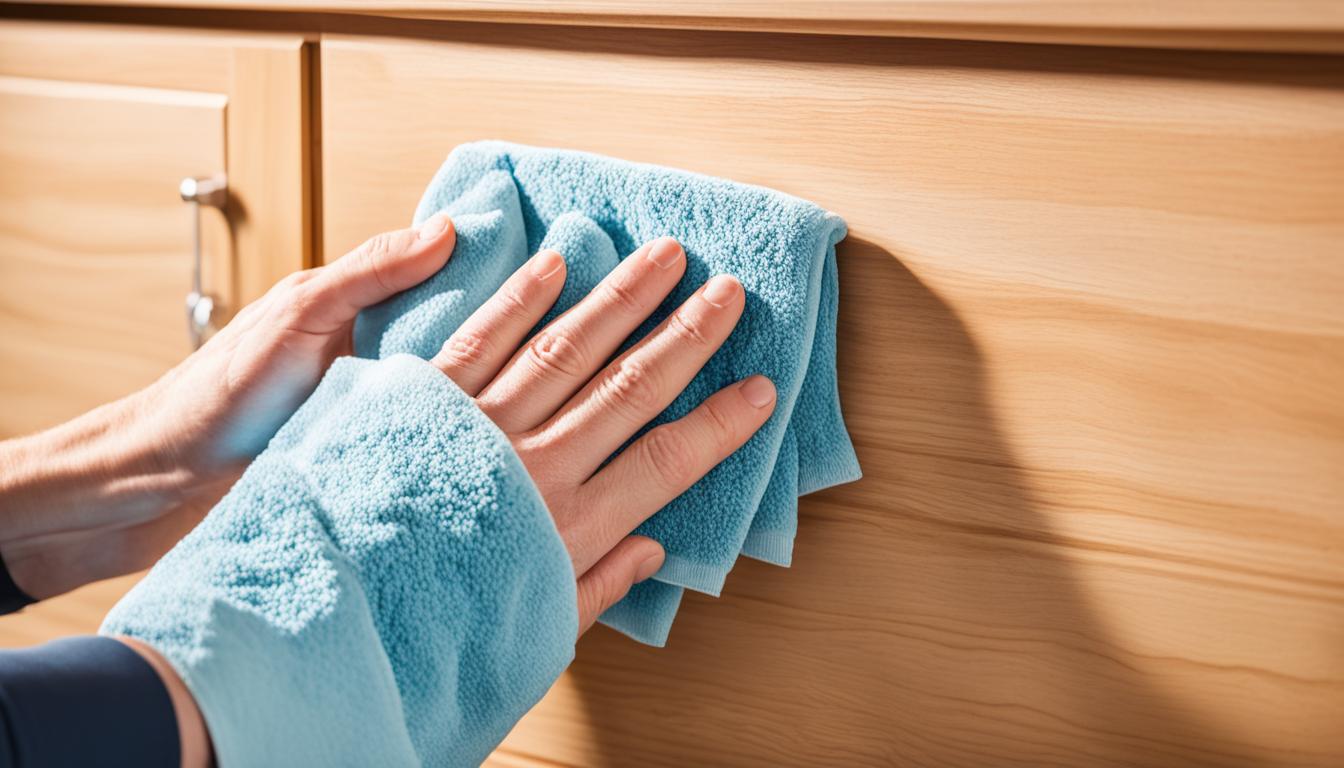Did you know that neglecting to clean and maintain your wood cabinets can lead to irreversible damage and degradation? Dust, grime, and spills can mar the appearance of your beautiful wooden cabinetry and even compromise its structural integrity. But fear not! With the right knowledge and techniques, you can easily keep your wood cabinets looking pristine for years to come.
Whether you want to know the best way to clean wood cabinets, learn tips for maintaining them, or discover natural wood cabinet cleaner options, this ultimate guide has got you covered. From everyday cleaning to deep cleaning and tackling sticky or greasy stains, I’ll walk you through all the steps and provide valuable insights for both DIY enthusiasts and those in search of professional wood cabinet cleaning solutions.
Key Takeaways:
- Regular cleaning is crucial for preserving the appearance and structural integrity of wood cabinets.
- Three key occasions for cleaning: immediate spills and stains, weekly spot-cleaning, and deep cleaning every few months.
- Use soft brushes or cloths, mild detergent mixed with water, and avoid water saturation to clean finished wood cabinets.
- Choose appropriate cleaners and techniques for sticky or greasy stains on wood cabinets.
- Use mild cleaning solutions, avoid harsh chemicals, and always test new cleaners on a small hidden area.
How to Clean Finished Wood Cabinets
When it comes to cleaning finished wood cabinets, a gentle approach is the key to maintaining their beauty and longevity. With the right tools and techniques, you can keep your cabinets looking stunning for years to come. Here are some essential tips for cleaning finished wood cabinets:
- Start by using soft brushes or non-abrasive cloths to remove loose dust and debris from the cabinet surfaces. This will prevent scratches and preserve the wood’s finish.
- Mix a mild detergent with water to create a gentle cleaning solution. Avoid using cleaners that contain ammonia, bleach, or other acidic or abrasive substances, as they can damage the wood.
- Dip a soft cloth or sponge into the cleaning solution and wring out any excess moisture. Gently wipe the cabinets, paying close attention to any stains or grime.
- Avoid saturating the wood with water. Wipe away spills and splatters immediately to prevent water damage.
- For stubborn stains, you can use a soft-bristled brush to gently scrub the affected area. Be careful not to scrub too hard, as this can remove the finish.
- Once you’re done cleaning, use a clean, dry cloth to remove any remaining moisture from the cabinets. This will help prevent water spots and streaks.
- Avoid using polishes and waxes continuously, as they can create a film on the wood’s surface and attract dirt and dust. Instead, opt for occasional use or natural alternatives like olive oil or beeswax.
By following these tips, you can effectively clean your finished wood cabinets without causing any damage. Remember to always test any new cleaning products on a small, inconspicuous area before applying them to the entire cabinet surface. With regular care and maintenance, your cabinets will continue to shine and enhance the beauty of your kitchen.
How to Clean Sticky Wood Cabinets
To clean sticky wood cabinets, it is essential to choose the right cleaner for the job. Whether you’re dealing with light or stubborn stains, there are effective solutions available. Here are some tips for cleaning sticky wood cabinets:
- Identify the type of stains on your wooden cabinetry. This will help you determine the most suitable cleaner for each specific problem.
- For light residue, an oil-based soap can work wonders. Apply a small amount of the soap onto a soft cloth and gently wipe the sticky areas. Make sure to follow the natural grain of the wood.
- If your cabinets are extremely grimy, consider using a hardwood cabinet cleaner or an all-purpose spray. These products are designed to tackle tough stains and build-up.
- When using any cleaner, it is always advisable to test it on a small, inconspicuous area of the cabinet first to ensure compatibility and avoid any potential damage.
- Repeat the cleaning process as needed until the sticky residue has been completely removed. Depending on the severity of the stains, you may need to use more abrasive materials or techniques.
Remember, regular cleaning and maintenance are key to keeping your wooden cabinets looking their best. By following these tips, you can say goodbye to sticky surfaces and enjoy clean and beautiful cabinets in your kitchen.

How to Clean Greasy Kitchen Cabinets
Grease stains can be a headache to clean from kitchen cabinets, but with the right approach, you can restore their shine and keep them looking pristine. Here are some effective tips for cleaning greasy kitchen cabinets:
- Start by gathering your cleaning supplies. You will need an oil-based soap, hot water and detergent, an adhesive remover, or an all-purpose cleaner.
- Begin the cleaning process by applying your chosen cleaner to a soft cloth or sponge.
- Gently scrub the greasy areas of the cabinets using a scouring pad or a damp cloth. Be careful not to scrub too hard, as it may damage the finish.
- If the grease stains are stubborn, you can try using an adhesive remover specifically designed for grease. Follow the instructions provided with the remover.
- For tough grease stains or built-up grime, a mixture of hot water and dish soap can be effective. Apply the solution to the cabinets and scrub gently.
- After cleaning, rinse the cabinets thoroughly with clean water to remove any residue. Use a clean cloth or sponge to wipe away any excess water.
- Repeat the cleaning process as needed to achieve a clean and grease-free surface.
Remember, prevention is key to keeping your kitchen cabinets free from grease. Wipe down surfaces regularly to remove any splatters or spills, and try to avoid cooking with excessive amounts of oil. By following these tips, you can keep your kitchen cabinets looking their best.
How to Clean Kitchen Cabinets: The Ultimate Guide
Keeping your kitchen cabinets clean is essential for maintaining a hygienic and organized cooking space. Regular cleaning helps remove accumulated grime, grease, and food splatters, ensuring your cabinets stay in top condition. In this comprehensive guide, I will share effective tips for cleaning kitchen cabinets and provide useful suggestions for maintaining their cleanliness.
Gather Your Cleaning Supplies
Before starting the cleaning process, gather the necessary supplies. You will need:
- Mild cleaning solution: Vinegar and water or dish soap and water
- Soft cloths or microfiber towels
- Toothbrush for scrubbing hard-to-reach areas
- Damp cloth for rinsing
Step-by-Step Cleaning Instructions
- Remove all items from the cabinets and set them aside.
- Prepare the cleaning solution by mixing equal parts vinegar and water or diluting dish soap with water.
- Dip a soft cloth or microfiber towel into the cleaning solution.
- Gently wipe down the cabinet surfaces, paying special attention to areas with visible stains or spills.
- For stubborn dirt or grease, use a toothbrush to scrub the affected areas.
- Rinse the surfaces with a damp cloth to remove any residue.
- Dry the cabinets thoroughly with a clean, dry cloth.
- Ensure the cabinets are completely dry before placing the items back inside.
Tips for Effective Cabinet Cleaning
- Regularly clean your kitchen cabinets to prevent the buildup of grime and grease.
- Wipe spills and splatters immediately to avoid stains and damage.
- Avoid soaking the cabinets or letting water enter the hinges, as it can cause swelling or warping.
- Consider using natural cleaning solutions, such as vinegar and water, for a chemical-free and eco-friendly approach.
- For an extra shine, you can apply a small amount of olive oil or wood polish. However, use these sparingly to prevent a greasy buildup.
By following these cleaning tips and maintaining a regular cleaning schedule, you can keep your kitchen cabinets looking pristine and extend their lifespan. A clean and organized kitchen not only enhances the overall aesthetic but also contributes to a healthier cooking environment.

What Cleaner is Safe for Wood Cabinets?
When it comes to cleaning your wood cabinets, it’s important to choose a safe and effective cleaner that won’t cause any damage. Harsh chemicals and abrasive substances can strip away the finish, leaving your cabinets looking dull and worn. So, what cleaner should you use to keep your wood cabinets looking their best?
A mild cleaning solution is the key to safely clean your wood cabinets. Two popular options are a mixture of white vinegar and water or dish soap and water. These gentle cleaners effectively remove dirt and grime without harming the wood or its finish.
Here’s how you can use these safe cleaning solutions:
- Mix equal parts white vinegar and water in a spray bottle. Or, combine a few drops of dish soap with warm water in a bucket.
- Dampen a soft cloth or sponge with the cleaning solution.
- Gently wipe down the cabinet surfaces, paying extra attention to any stains or spills.
- Rinse the cloth or sponge frequently to avoid spreading dirt.
- After cleaning, use a dry cloth to remove any excess moisture.
By using a mild cleaning solution, you can safely remove dirt, grease, and grime from your wood cabinets without causing any harm. It’s always a good idea to test the cleaner on a small, hidden area of the cabinet first to ensure compatibility with the finish. For different types of stains or tougher cleaning jobs, you can adjust the concentration of the cleaning solution or try other safe options.
Image:
Remember to follow the instructions provided on the cleaner’s bottle for the best results. With the right cleaning solution, you can keep your wood cabinets looking beautiful and well-maintained for years to come.
Final Thoughts on Cleaning Kitchen Cabinets
Cleaning kitchen cabinets is an essential part of maintaining a clean and hygienic kitchen. Regular cleaning not only helps to keep your cabinets looking their best but also prevents permanent damage. By incorporating a simple cleaning routine, you can extend the lifespan of your cabinets and enjoy a fresh and organized kitchen.
It is recommended to clean your kitchen cabinets on a weekly basis to remove dust, grease, and other residues that can accumulate over time. A gentle wipe down with a mild cleaning solution, such as a mixture of vinegar and water or dish soap and water, is usually sufficient to remove surface dirt and grime. Pay extra attention to handles and hardware, as these areas tend to collect more dirt.
In addition to regular cleaning, it is important to perform a thorough cleaning of your kitchen cabinets at least once a month. This includes emptying the cabinets, checking for any damages, and wiping down the interior surfaces. Take this opportunity to declutter and reorganize your cabinets, discarding any expired or unused items.
To maintain clean cabinets and protect them from future stains, consider applying a finishing touch using a mixture of vegetable oil and vinegar. This natural solution helps to create a protective barrier against dirt and grime, keeping your cabinets looking fresh for longer.
